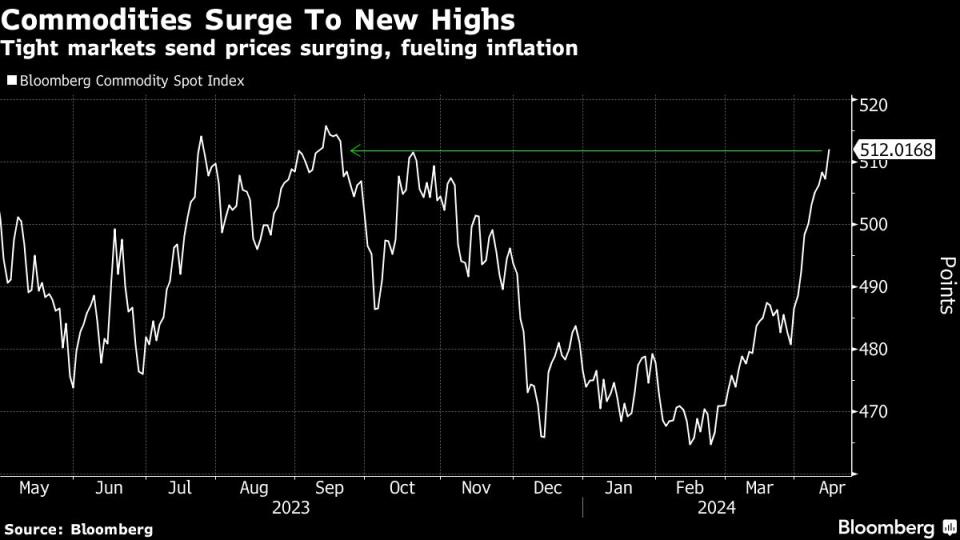Hot Commodity Markets Are Dogging Inflation-Wary Central Banks
(Bloomberg) -- A new commodities boom is complicating central bankers’ anti-inflation efforts and may help derail prospects for significant interest-rate cuts any time soon.
Most Read from Bloomberg
Beyond the Ivies: Surprise Winners in the List of Colleges With the Highest ROI
Trump Media’s $5.3 Billion Selloff Deepens as 270% Rally Fizzles
S&P 500 Breaks Below 5,100 as Big Tech Sells Off: Markets Wrap
Iran’s Attack on Israel Sparks Race to Avert a Full-Blown War
Even before Iran’s attack on Israel over the weekend stoked fears of a wider regional war and disruption to oil supplies, crude had already risen significantly this year. That advance, together with a renewed exuberance in markets for precious metals and other raw materials, has pushed the Bloomberg Commodity Spot Index to an almost seven-month high.
The rally in oil makes gasoline costlier in the US, where pump prices are a political hot-button issue, especially in an election year. Copper, which is essential for wiring, plumbing and industrial machinery, is at highs last seen in mid-2022. Coffee prices have also leaped this year, while cocoa’s surge to an all-time high has thrown the chocolate industry into disarray.
Last week, the US core consumer price index rose more than expected, delaying expectations for a US Federal Reserve rate cut. Two of the biggest drivers were gasoline and electricity prices.
“This latest rally makes it much tougher for central banks to ease interest rates,” said Trevor Woods, chief investment officer of Northern Trace Capital LLC, which is long across several commodities.
Investors are piling back into exchange-traded funds that track commodity indices, with the 20 largest, broad-based commodity ETFs pulling in roughly $1 billion since the beginning of March, according to data compiled by Bloomberg. At the same time, investors who fled commodities during the late-2023 selloff are now jostling to get back in.
“Stickier-than-expected inflation is a big part of commodity inflows, creating demand for portfolio hedges,” said Ryan Fitzmaurice, a senior commodities strategist at Marex. “A rotation back into commodities would not surprise me given the recent CPI misses.”
While the commodities sector comprises a diverse group of raw materials mined, extracted or harvested across practically every time zone, many of the most significant index components are rallying strongly at the same time. Higher raw-material prices are feeding into inflation and threatening to keep it elevated for longer.
Oil, the biggest and most consequential commodity market, has climbed this year amid escalating conflict in the Middle East coupled with higher-than-expected demand and flat supplies. Last week, Brent crude traded at more than $92 a barrel for the first time since October.
Industrial metals with a role to play in electric cars and data centers also are having a moment. But no commodity’s year-to-date gains even approach the more than doubling in cocoa that has candy makers shrinking packages and chocolate-lovers bracing for the worst.
Collectively, this all adds up to higher prices for consumers. Pacific Investment Management Co. recently warned that the Fed could resort to rate hikes if inflation keeps running hot. Markets currently see rates at about 4.9% when the Fed convenes in December — that compares with an expectation of 3.8% at the start of this year.
Conversely, gold has been hitting fresh highs on an almost-daily basis as increasing anxiety about inflationary pressures drives investors into safe-haven assets.
The renewed appetite for commodity investments partly shows up in the total value of derivatives contracts in the sector that traders are holding. That climbed to a seven-month high of $1.35 trillion at the end of March, according to JPMorgan Chase & Co.
“The Fed could take its time easing rates and if they stay higher for longer, we’ll probably see other central banks around the world ease before we do,” said J.D. Joyce, president of Joyce Wealth Management LLC in Houston.
To be sure, not all commodities are rallying. Natural gas prices in the US have been so low that some producers are shutting wells. Outside of cocoa, many agricultural markets have been softer on ample supply prospects, meaning less risk to food prices around the globe.
Nor is it certain that oil can rally much further from here even if tensions continue to mount in the Middle East. Despite Iran launching more than 300 missiles and drones at Israel, Brent crude prices were little changed when trading resumed in Asian hours Monday.
“Any rise in oil prices on higher geopolitical risks may be dampened by oil producers deciding to hedge their price risks and sell forward their production,” Goldman Sachs Group Inc. analysts said Sunday in a note.
How long will the current commodities rally last? Although analysts at Macquarie Group Ltd. said last month that energy and commodities are entering the “the first throes of a cyclical upswing,” most observers aren’t calling this the beginning of another supercycle.
If input prices get too high it can ultimately damp consumer demand for finished goods. And any kind of economic slowdown due to inflation could be bad news for President Joe Biden as he tries to convince voters he’s managed the economy well during his time in the White House.
“Commodities are the significant input for many industries and rising prices will start to hurt growth if higher prices are not able to be passed along to consumers,” said Rebecca Babin, senior energy trader at CIBC Private Wealth.
--With assistance from Joe Carroll.
Most Read from Bloomberg Businessweek
A Resilient Global Economy Masks Growing Debt and Inequality
Top Takeaways From Businessweek’s Investigation of Teenage Sextortion
Race for AI Supremacy in Middle East Is Measured in Data Centers
©2024 Bloomberg L.P.




